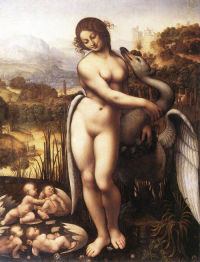Imagination and Invention Click on the thumbnails to explore the trail
Read more about this trail (expand)
The exercise of imaginative fantasy was as much an integral part of Leonardo’s mind as the discipline of scientific observation. For the artist, imagination was dependent upon an accurate understanding of observational input – a complete comprehension of the geometry of God’s design. Sensory impressions gained from observation were recombined by the artist’s ‘fantasia’ or imagination, to create new and credible forms
Leda and the Swan (copy after Leonardo) 16th century
Classical antiquity fuelled the imaginations of many Renaissance artists. Leonardo’s interest seems to have intensified while in Florence, when between 1503 and 1506 he worked on the Battle of Anghiari fresco in the government palace in Florence.
In this painting inspired by classical mythology, Leonardo has given free rein to his powers of invenzione to create the beautiful figure of Leda, the legendary mother of Castor and Pollux, and Helen of Troy. While the figure of Leda is clearly modelled on sculptural prototypes such as statues of Venus, Leonardo has applied his knowledge of anatomy to breathe life into her painted form. In fact, all of the elements of this painting seem to pulsate with life.
Surviving drawings indicate that Leonardo spent a good deal of time designing Leda’s elaborate plaited wig. The curls of her own hair stick out through two openings in the swirls at the sides, like mountains from a spring, a symbol of nature’s regenerative powers, which is perhaps the subtext of this painting. We can only wonder at the quality of Leonardo’s original painting from which this work has been derived.
In Leonardo's words
Truly painting is a science, the true-born child of nature. For painting is born of nature; to be more correct we should call it the grandchild of nature, since all visible things were brought forth by nature and these, her children, have given birth to painting.
According to Greek myth, Leda was seduced by the God Zeus, who came to her at the river in the form of a swan. Their union resulted in the creation of Helen of Troy, Clytemnestra, Castor and Pollux, who hatched from two eggs.
Leonardo's interest in the theme is testified in a group of surviving drawings, in which he explored different compositional solutions, first with Leda kneeling and then standing. Drawings at Chatworth, Derbyshire, and the Museum Boijmans Van Beuningen, Rotterdam, can be dated to around 1506-08 and show Leda standing, but it would seem that Leonardo was already working on the theme of a kneeling Leda as early as 1504 as preliminary sketches appear on drawings related to the Battle of Anghiari mural, on which at that time Leonardo was working.
Three sketches of the Leda have drawn framing outlines around the composition, suggesting that Leonardo did intend to execute a painting of Leda at some point, although no painting of the subject by his hand survives today. A painted copy by Leonardo's pupil Giampetrino now in the Staatliche Museen, Berlin, vividly evokes the master's idea for a kneeling Leda, while a drawn copy by Raphael reflects Leonardo's standing version of the theme. Leonardo's own surviving drawings for the Leda include botanical studies drawn from nature and speak of the timeless notions of fecundity, birth, and nature's regenerative power.
- Medium Oil on wood panel
- Size 69.5 x 73.7 cm
- Location Collection of the Earl of Pembroke












